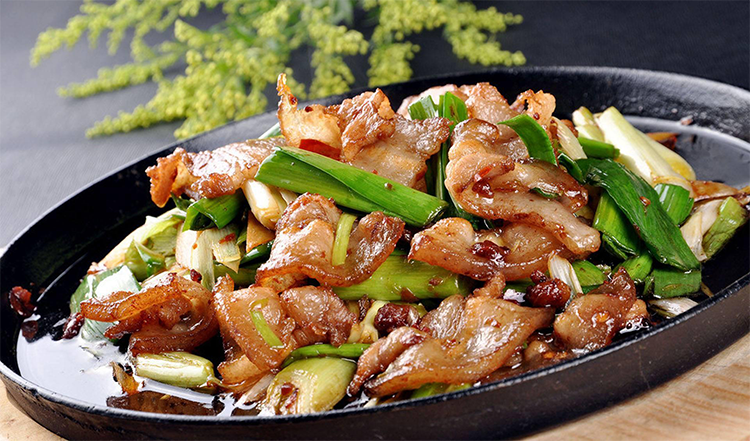Hui Guo Rou: Sichuan’s Twice-Cooked Pork
1. Origin: A Flavor That Traveled Through Time
Hui Guo Rou, known as Twice-Cooked Pork, traces its roots back to the Ming Dynasty. The name reflects its cooking process: pork is first simmered, then sliced and stir-fried again. The arrival of chili peppers during the Ming and Qing dynasties reshaped Sichuan flavors, adding signature spiciness. The introduction of Pixian Broad Bean Paste—a fermented chili-bean condiment—brought rich umami depth, helping Hui Guo Rou become an icon of Sichuan cuisine.
2. More Than a Dish: A Cultural Symbol
In Sichuan, Hui Guo Rou represents more than just a meal. Traditionally, families prepared it on the lunar first and fifteenth days, known as “da yaji,” marking abundance and reunion. Today, it remains a symbol of warmth and togetherness. Tasting Hui Guo Rou is not only a culinary delight but also a glimpse into Sichuan’s rich cultural heritage.
3. Secrets of Its Core Ingredients
The signature taste of Hui Guo Rou comes from the perfect combination of quality ingredients. The ideal pork cut balances fat and lean layers, usually the rear shoulder, so each slice curls beautifully when fried. Pixian Broad Bean Paste brings savory, spicy, and aromatic complexity, while fresh garlic shoots or green peppers add a refreshing contrast that cuts through the richness.
4. Cooking as Craft: Key Steps
Cooking Hui Guo Rou requires skill and precision. First, simmer the pork with ginger, scallion, and peppercorns until nearly cooked. Cool it quickly, then slice thinly. Fry the slices to render fat and form curled, golden edges. Add Pixian Broad Bean Paste and stir-fry until it releases its red oil and aroma. Toss in garlic shoots for a brief, high-heat finish so that every piece glistens with sauce. Serve immediately for the best texture and taste.

5. Flavor and Texture: Fat Yet Not Greasy
On the plate, Hui Guo Rou’s vibrant red color is irresistible. Each bite combines crispy edges, tender meat, and a balance of savory heat. The fatty parts melt smoothly, while the lean portions soak up the sauce. The dish’s magic lies in its balance—rich but not oily, spicy but not overwhelming, flavorful yet clean.
6. How Locals Enjoy It
Hui Guo Rou is best served hot and pairs perfectly with steamed rice. Locals often place a slice of pork and garlic shoot over rice, letting the sauce soak into the grains. It’s a signature Sichuan home-style dish, often served with light soups and vegetables for balance. Travelers sensitive to spice can request a milder version, though the bold original remains most authentic.
7. Where Travelers Find the Most Authentic Taste
For the truest experience, head to Chengdu or Chongqing. Visit traditional restaurants or small neighborhood eateries renowned for authentic Sichuan cuisine. Look for “Hui Guo Rou” on the menu—authentic versions always feature garlic shoots. Pair it with a clear soup and a vegetable side, and savor it fresh off the wok.
8. A Simple Home Version to Try
You can easily recreate Hui Guo Rou at home using basic ingredients:
Ingredients: 300g pork belly, 5–6 garlic shoots, 1.5 tbsp Pixian Broad Bean Paste, ginger slices, cooking wine, sugar, and oil.
Steps:
- Boil pork with ginger and wine until tender, then cool and slice thinly.
- Cut garlic shoots diagonally, separating white and green parts.
- Stir-fry pork slices until edges curl and fat renders.
- Add Pixian Broad Bean Paste, fry until red oil appears, then mix with pork.
- Add garlic-shoot whites, then greens; sprinkle a pinch of sugar and stir briefly before serving.
Though the home version may lack restaurant-style “wok aroma,” it still captures the essence of authentic Sichuan Twice-Cooked Pork.
9. Summary
Hui Guo Rou, the king of Sichuan cuisine, tells the region’s culinary story through its bold yet balanced flavors. Try it in Chengdu, taste the depth of Pixian Broad Bean Paste, and let this timeless classic become a highlight of your China food journey.


